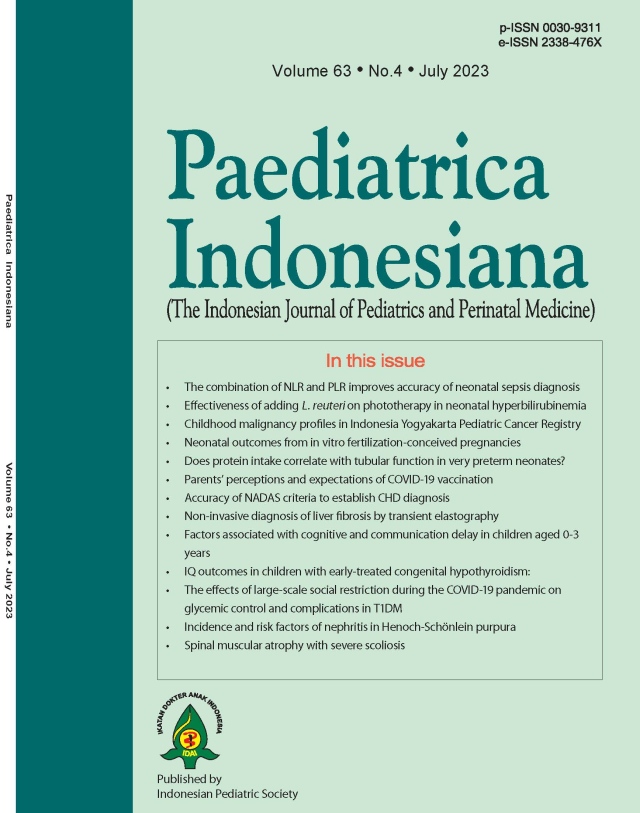The combination of neutrophil to lymphocyte ratio and platelet to lymphocyte ratio improves accuracy of neonatal sepsis diagnosis
Abstract
Background Neonatal sepsis remains a challenging issue, due to sophisticated and time consuming tests needed to confirm a diagnosis.
Objective To assess the applicability of neutrophil to lymphocyte ratio (NLR) and platelet to lymphocyte ratio (PLR) as diagnostic markers in neonatal sepsis.
Methods This cross-sectional study was conducted in the Neonatology Ward of Kandou General Hospital, Manado, North Sulawesi. Neonates with suspected sepsis were included by consecutive sampling. We measured NLR and PLR form hematology profiles and differential count. Diagnosis of neonatal sepsis was based on positive blood cultures. A receiver operating characteristic (ROC) curve analysis was done to assess the NLR and PLR cut-off points. Chi-square test was used to analyze the diagnostic value of NLR and PLR.
Results A total of 176 full term neonates with suspected sepsis were included in the study. Of these, 84 (47.7%) subjects were confirmed with neonatal sepsis and 92 (52.3%) were non-sepsis. The mean NLRs were 5.9 (95%CI 2.0 to 13.6) in the sepsis group and 1.6 (95%CI 0.2 to 3.2) in the non-sepsis group. A NLR of 3.0 was determined as the predictive cut-off value of neonatal sepsis (sensitivity 94%, speci?city 97.8%, and area under the ROC curve 0.995). NLR can effects on neonatal sepsis diagnosis by 61% . The mean PLRs were 79.9 (95%CI 44.0 to 155.8) in the sepsis group and 44.0 (95%CI 9.7 to 91.8) in the non-sepsis group. A PLR of 60.4 was determined as the predictive cut-off value of neonatal sepsis (sensitivity 86.9%, speci?city 87%, area under ROC curve 0.928). PLR can effects on neonatal sepsis diagnosis by 47.5%. When NLR and PLR were combined, they can improve accuracy of neonatal sepsis diagnosis about 72.2%.
Conclusion Neutrophil to lymphocyte ratio (NLR) and platelet to lymphocyte ratio (PLR) can be used in combination as adjunct diagnostic tests for neonatal sepsis workups.
References
2. Simonsen KA, Anderson-Berry AL, Delair SF, Davies HD. Early-onset neonatal sepsis. Clin Microbiol Rev. 2014;27:21-47. DOI: https://doi.org/10.1128/CMR.00031-13.
3. Amare D, Mela M, Dessie G. Unfinished agenda of the neonates in developing countries: magnitude of neonatal sepsis: systematic review and meta-analysis. Heliyon. 2019.;5:e02519. DOI: https://doi.org/10.1016/j.heliyon.2019.e02519.
4. Shane AL, Sánchez PJ, Stoll BJ. Neonatal sepsis. Lancet. 201714;390(10104):1770-80. DOI: https://doi.org/10.1016/S0140-6736(17)31002-4. .
5. Badan Pusat Statistik, Badan Koordinator Keluarga Berencana Nasional, Kementerian Kesehatan, ICF International. Indonesia demographic and health survey 2012. Jakarta: BPS, BKKBN, Kemenkes, ICF International; 2013. [cited 2020 Apr 09]. Available from: https://www.dhsprogram.com/publications/publication-FR275-DHS-Final-Reports.cfm.
6. Sharma D, Farahbakhsh N, Shastri S, Sharma P. Biomarkers for diagnosis of neonatal sepsis: a literature review. J Matern Fetal Neonatal Med. 2018;31:1646-59. DOI: https://doi.org/10.1080/14767058.2017.1322060.
7. Camacho-Gonzalez A, Spearman PW, Stoll BJ. Neonatal infectious diseases: evaluation of neonatal sepsis. Pediatr Clin North Am. 2013 Apr;60(2):367-89. DOI: https://doi.org/10.1016/j.pcl.2012.12.003.
8. Meem M, Modak JK, Mortuza R, Morshed M, Islam MS, Saha SK. Biomarkers for diagnosis of neonatal infections: A systematic analysis of their potential as a point-of-care diagnostics. J Glob Health. 2011;1:201-9. PMID: 23198119
9. Omran A, Maaroof A, Saleh MH, Abdelwahab A. Salivary C-reactive protein, mean platelet volume and neutrophil lymphocyte ratio as diagnostic markers for neonatal sepsis. J Pediatr (Rio J). 2018;94:82-87. DOI: https://doi.org/10.1016/j.jped.2017.03.006.
10. Tamelyt? E, Vai?ekauskien? G, Dagys A, Lapinskas T, Jankauskait? L. Early blood biomarkers to improve sepsis/bacteremia diagnostics in pediatric emergency settings. Medicina (Kaunas). 2019;55:99. DOI: https://doi.org/10.3390/medicina55040099.
11. Pantzaris ND, Platanaki C, Pierrako C, Karamouzos V, Velissaris D. Neutrophil-to-lymphocyte ratio relation to sepsis severity scores and inflammatory biomarkers in patients with community-acquired pneumonia: A Case Series. J Transl Int Med. 2018 Mar 28;6:43-46. DOI: https://doi.org/10.2478/jtim-2018-0009.
12. Arcagok BC, Karabulut B. Platelet to lymphocyte ratio in neonates: a predictor of early onset neonatal sepsis. Mediterr J Hematol Infect Dis. 2019;11:e2019055. DOI: https://doi.org/10.4084/MJHID.2019.055.
13. Coscia A, Di Nicola P, Bertino E, Fabris C. Physical examination of the newborn. In: Buonocore G, Bracci R, Weindling M. (eds). Neonatology. New York: Springer Cham; 2018. DOI: https://doi.org/10.1007/978-3-319-29489-6_181.
14. Verma P, Berwal PK, Nagaraj N, Swami S, Jivaji P, Narayan S. Neonatal sepsis: epidemiology, clinical spectrum, recent antimicrobial agents and their antibiotic susceptibility pattern. Int J Contemp Pediatr. 2015;2:176-80. DOI: https://doi.org/10.18203/2349-3291.ijcp20150523.
15. Aminullah A. Sepsis in newborn. In: Kosim MS, Yunanto A, Dewi R, Sarosa GI, Usman A, editors. Textbook of neonatology. Jakarta: IDAI; 2012. p. 170-87.
16. Rohsiswatmo R, Dewanto NE, Rizalya D. Sepsis in neonates. Jakarta: IDAI; 2010. p. 107-87.
17. Ozdemir SA, Ozer EA, Ilhan O, Sutcuoglu S. Can neutrophil to lymphocyte ratio predict late-onset sepsis in preterm infants?. J Clin Lab Anal. 2018;32:e22338. DOI: https://doi.org/10.1002/jcla.22338.
18. Tuzun F, Ozkan H, Cetinkaya M, Yucesoy E, Kurum O, Cebeci B, et al. Is European Medicines Agency (EMA) sepsis criteria accurate for neonatal sepsis diagnosis or do we need new criteria? PLoS One. 2019;14:e0218002. DOI: https://doi.org/10.1371/journal.pone.0218002.
19. Kardana IM. Incidence and factors associated with mortality of neonatal sepsis. Paediatr Indones. 2011;51:144-8. DOI: https://doi.org/10.14238/pi51.3.2011.144-8.
20. Hanaganahalli SB, Sreeram S, Bompada M, Kuppannagari SK, Suresh PK, Philipose CS. Is MPV a Predictive Marker for Neonatal Sepsis? A Pilot Study. J Pediatr Hematol Oncol. 2018;40:548-52. DOI: https://doi.org/10.1097/MPH.0000000000001272.
21. Wilar R. Diagnostic value of eosinopenia and neutrophil to lymphocyte ratio on early onset neonatal sepsis. Korean J Pediatr. 2019;62:217-223. DOI: https://doi.org/10.3345/kjp.2018.06723.
22. Hotchkiss RS, Osmon SB, Chang KC, Wagner TH, Coopersmith CM, Karl IE. Accelerated lymphocyte death in sepsis occurs by both the death receptor and mitochondrial pathways. J Immunol. 2005;174:5110-8. DOI: https://doi.org/10.4049/jimmunol.174.8.5110.
23. Hotchkiss RS, Monneret G, Payen D. Sepsis-induced immunosuppression: from cellular dysfunctions to immunotherapy. Nat Rev Immunol. 2013;13:862-74. DOI: https://doi.org/10.1038/nri3552.
24. Shen Y, Huang X, Zhang W. Platelet-to-lymphocyte ratio as a prognostic predictor of mortality for sepsis: interaction effect with disease severity-a retrospective study. BMJ Open. 2019;9:e022896. DOI: https://doi.org/10.1136/bmjopen-2018-022896.
25. Nording HM, Seizer P, Langer HF. Platelets in inflammation and atherogenesis. Front Immunol. 2015;6:98. DOI: https://doi.org/10.3389/fimmu.2015.00098.
Copyright (c) 2023 Rocky Wilar, Beatrice Koesmarsono, Stefanus Gunawan

This work is licensed under a Creative Commons Attribution-NonCommercial-ShareAlike 4.0 International License.
Authors who publish with this journal agree to the following terms:
Authors retain copyright and grant the journal right of first publication with the work simultaneously licensed under a Creative Commons Attribution License that allows others to share the work with an acknowledgement of the work's authorship and initial publication in this journal.
Authors are able to enter into separate, additional contractual arrangements for the non-exclusive distribution of the journal's published version of the work (e.g., post it to an institutional repository or publish it in a book), with an acknowledgement of its initial publication in this journal.
Accepted 2023-07-31
Published 2023-07-31













